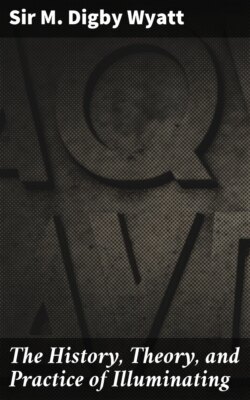The History, Theory, and Practice of Illuminating

Реклама. ООО «ЛитРес», ИНН: 7719571260.
Оглавление
Sir M. Digby Wyatt. The History, Theory, and Practice of Illuminating
The History, Theory, and Practice of Illuminating
Table of Contents
PART I
WHAT ILLUMINATING WAS
WHAT ILLUMINATING SHOULD BE IN THE PRESENT DAY
PART II
HOW ILLUMINATING MAY BE PRACTISED
FOOTNOTES
Отрывок из книги
Sir M. Digby Wyatt
Condensed from 'The Art of Illuminating' by the same illustrator and author
.....
Roman illuminated manuscripts would appear, therefore, to have been mainly divisible into two classes; firstly, those in which the text, simply but elegantly written in perfectly-formed, or rustic (that is, inclined) capitals, mainly in black and sparingly in red ink, was illustrated by pictures, usually square, inserted in simple frames, generally of a red border only; and secondly, the richer kind, in which at first gold letters, on white and stained vellum grounds, and subsequently black and coloured letters and ornaments on gold grounds, were introduced. The first of these appears to have been the most ancient style, and to have long remained popular in the Western Empire, while the second, which, as Sir Frederick Madden has observed, no doubt came originally to the Romans from the Greeks, acquired its greatest perfection under the early emperors of the East.
Of both styles there are still extant some invaluable specimens, which, although not of the finest periods of art, may still be regarded as typical of masterpieces which may have existed, and which fire or flood, Goth or Vandal, may have destroyed. Before proceeding, however, to an enumeration of any of these, it may be well to define certain terms which must be employed to designate the peculiarities of character in which the different texts were written, some slight knowledge of which is of great assistance in arriving at a proximate knowledge of the dates at which they may have been executed. Such a definition cannot be more succinctly given than in the following passage, extracted from Mr. Noel Humphrey's interesting work "On the Origin and Progress of the Art of Writing:"—[5]
.....